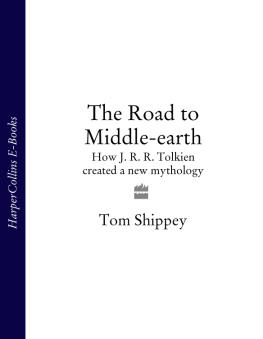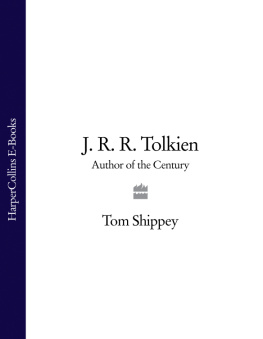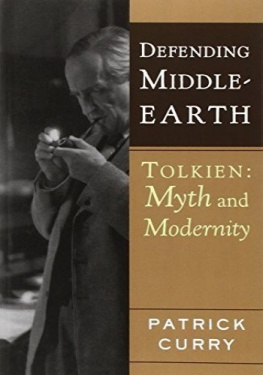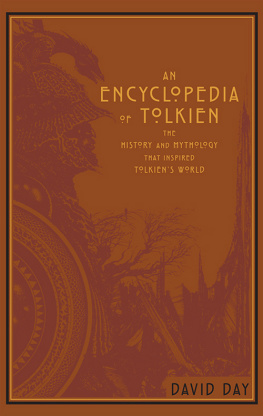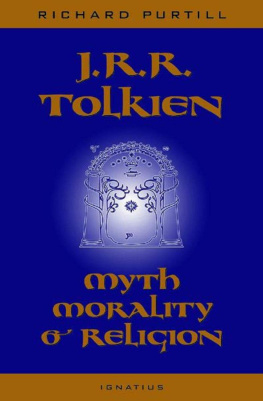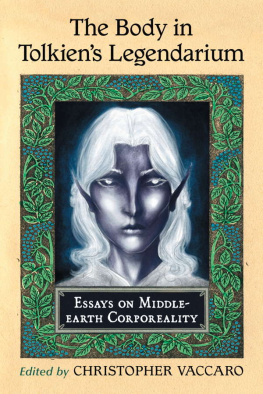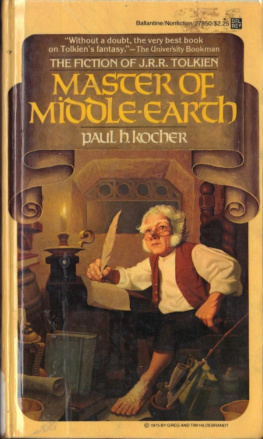I have incurred many debts in the writing of the three editions of this book, firstly and most importantly from Professor Tolkien himself, for a prompt and salutary correction, as mentioned in the Preface below. I hope that over the years I have come to realise and to express some part of what he meant.
This book could further not have been written without the immense assistance of Humphrey Carpenters three works, J.R.R. Tolkien: a Biography, The Inklings, and the Letters of J. R. R. Tolkien, edited by Mr Carpenter with the assistance of Christopher Tolkien. They have provided a frame for my inquiries, and I have referred to them continually. Both Mr Carpenter and Mr Tolkien furthermore read many hundreds of pages of typescript for the first edition, and corrected many errors, both factual and of interpretation, thoughtfully and magnanimously. Those that remain are my responsibility alone, as is the general trend of this books argument, which no adviser, perhaps, could satisfactorily modify. I am much indebted also to the late and much-regretted Rayner Unwin for encouragement without pressure over too long a period; and to Mrs Pam Armitage for typing repeated drafts of the first edition (written before word-processors came into general use) with exemplary care.
Friends and colleagues past and present have provided me with much additional information, in particular, for the first edition, John Bourne, Lesley Burnett, Janet and Malcolm Godden, Tony Green, Constance Hieatt, David Masson and Rory McTurk; while Tolkienists both within and without the Tolkien Society have put me straight on details. I must thank especially Rhona Beare and Jessica Yates for many long letters and contributions, as also Charles Noad and Gary Kuris. For this third edition, I have had yet more assistance, gratefully acknowledged, from Douglas Anderson, David Bratman, Patrick Curry, Charles Noad (again), Carl Hostetter, John Rateliff, and Dan Timmons. Some of these debts are acknowledged more fully in text and notes.
Cornell University Press has kindly permitted me to reproduce in successive editions the substance of my chapter Creation from Philology in The Lord of the Rings, from J.R. R. Tolkien, Scholar and Story-Teller, edited by Mary Salu and Robert T. Farrell, 1979; and also, in this and the second edition, the stemma from Theodore Anderssons The Legend of Brynhild, 1979, for which I also have to thank Dr Andersson. The University of Turku, Finland, has given the same permission for Tolkien as a Post-War Writer, in Scholarship and Fantasy: The Tolkien Phenomenon, ed. Keith J. Battarbee, 1993, as have Greenwood Press for Orcs, Wraiths, Wights: Tolkiens Images of Evil, in J.R.R. Tolkien and his Literary Resonances, ed. Dan Timmons and George Clark, 2000, and Houghton Mifflin for Another Road to Middle-earth: Jacksons Movie Trilogy, in Understanding The Lord of the Rings, ed. Neil D. Isaacs and Rose Zimbardo, 2004.
I have also to thank Tolkiens literary executors for permission to translate the four poems in Appendix B. They and HarperCollins have further allowed me to quote freely from all Tolkiens published works. Thanks are due to the Oxford University Press for permission to quote from the Oxford English Dictionary, and indeed the most courteous deed of all is that of Mr Robert Burchfield, formerly the Dictionarys General Editor, who gave such permission in spite of all the shafts which Tolkien and I have levelled at the work of his predecessors. It should not need me to say that, whatever additions one can make to it, the OED remains the most useful work any English critic can possess.
When it comes to citation of ancient texts (as in this book it often does) I have not given full references in academic style. Partly this is because they would be useless to the general reader. More forcefully, one can say that there is no subject for which standard editions are less relevant than the works of Tolkien. He knew Beowulf, and the Anglo-Saxon Poetic Records, and the Elder Edda, and Pearl and Sir Gawain and Saxo Grammaticus, a good deal better than most of their editors, even when, as happened occasionally, his earlier self was the editor. It may be taken, then, that standard editions have been referred to, and some are cited in Appendix A to this work, but quotations rest on the authority of the original manuscripts, and have sometimes been emended to what I think are the most Tolkienian forms. With Old English and Old Norse I have used marks of vowel-length similar to those in The Lord of the Rings, though I have not introduced them to The Hobbit nor to much-mentioned Old English names such as Beowulf (Beowulf). All translations, unless separately acknowledged, are my own.
Abbreviations used in the text and notes are as follows (all works mentioned being by Tolkien himself, unless otherwise stated). Dates of first publication are given as well as editions actually used.
| Artist | Wayne G. Hammond and Christina Scull, J.R.R. Tolkien, Artist and Illustrator (London: HarperCollins, 1995) |
| Author | Tom Shippey, J.R.R. Tolkien: Author of the Century (London: HarperCollins, 2000). |
| AW | Ancrene Wisse and Hali Meihad, Essays and Studies vol. 14 (1929), pp. 10426. |
| Bibliography | Wayne G. Hammond, with Douglas A. Anderson, J.R.R. Tolkien: A Descriptive Bibliography (St Pauls Bibliographies: Winchester, 1993; Oak Knoll Books: New Castle, DW, 1993). |
| Biography | J.R.R. Tolkien: a Biography, by Humphrey Carpenter (1977; London: HarperCollins, 2002, the latter containing an updated list of Tolkiens published works). |
| BLT1 | The Book of Lost Tales, Part One, edited by Christopher Tolkien (London: George Allen & Unwin, 1983). |
| BLT2 | The Book of Lost Tales, Part Two, edited by Christopher Tolkien (London: George Allen & Unwin, 1984). |
| Essays | The Monsters and the Critics and other essays, edited by Christopher Tolkien (London: George Allen & Unwin, 1983). |
| EW | English and Welsh, in Angles and Britons: ODonnell Lectures (Cardiff: University of Wales Press, 1963), pp. 141. Reprinted in Essays. |
| Exodus | The Old English Exodus: Text, Translation and Commentary, edited by Joan Turville-Petre (Oxford: Clarendon, 1981). |
| Finn | Finn and Hengest: the Fragment and the Episode, edited by Alan Bliss (London: George Allen & Unwin, 1982). |
| Giles | Farmer Giles of Ham (London: George Allen & Unwin, 1949). Reprinted in and here cited from Tales. |
| Guide | Guide to the Names in The Lord of The Rings in A Tolkien Compass, edited by Jared Lobdell (La Salle, Illinois: Open Court, 1975), pp. 153201.
|
| Hobbit | The Hobbit: or There and Back Again (1937; cited here from the corrected edition, with Note on the Text by Douglas A. Anderson, London: HarperCollins, 2001). |
| Homecoming | The Homecoming of Beorhtnoth Beorhthelms Son, Essays and Studies N.S. vol. 6 (1953), pp. 118. Reprinted in and here cited from Tree. |
| Inklings | The Inklings: C.S. Lewis, J.R.R. Tolkien, Charles Williams and their friends, by Humphrey Carpenter (London: George Allen & Unwin, 1978). |
| Jewels | The War of the Jewels: The Later Silmarillion, Part Two, The Legends of Beleriand |

